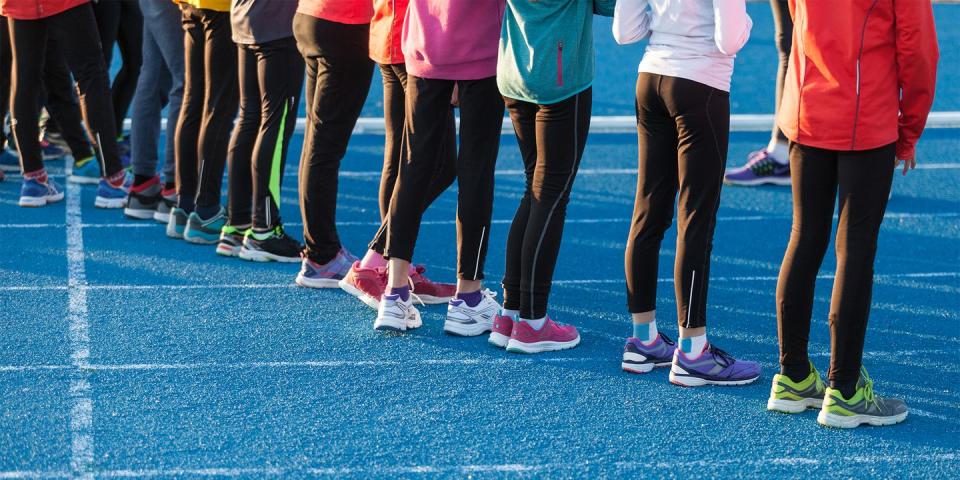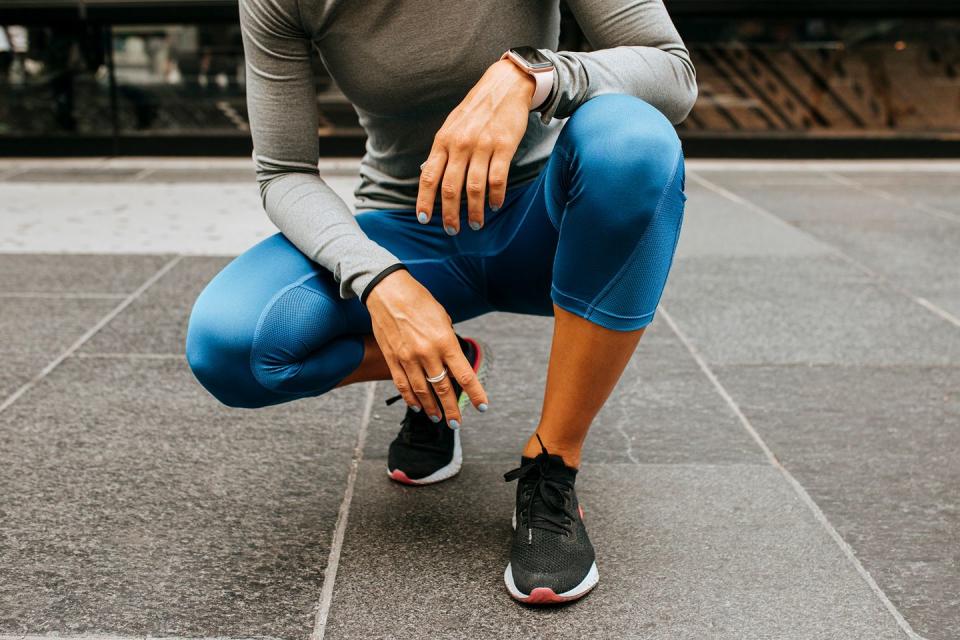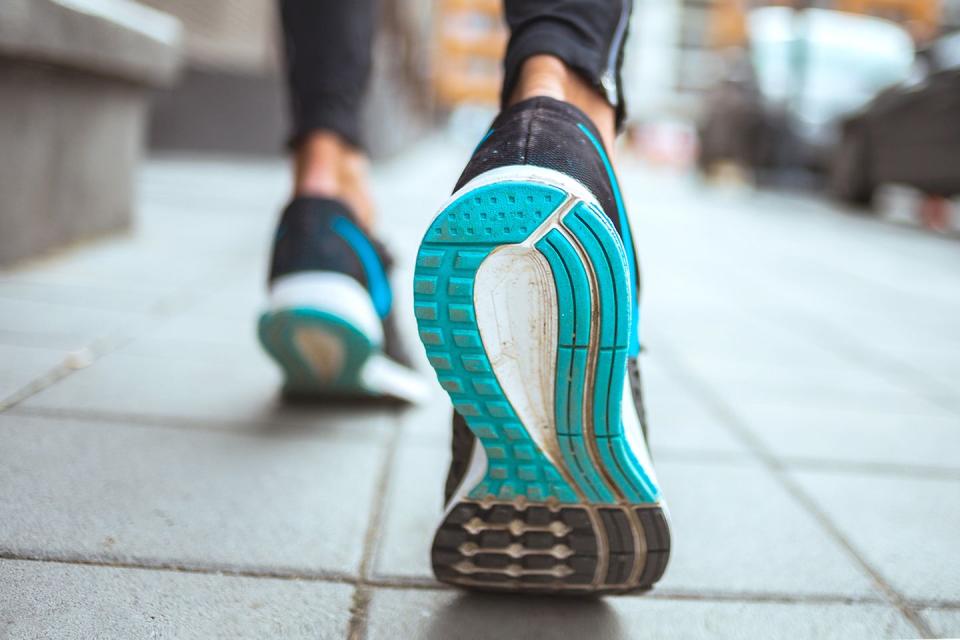If You Need Arch Support, These Sneakers Help to Ease Pain While You're on the Move

“Hearst Magazines and Verizon Media may earn commission or revenue on some items through the links below.”
How often do you think about your plantar fascia? Probably never — and that’s OK. It typically does its job without much fuss, so you usually don’t need to worry about it.
“The plantar fascia is a strong ligament that attaches the heel to the toes,” says Paul Langer, a sports medicine podiatrist at Twin Cities Orthopedics in Minneapolis and an expert for Superfeet. “Its job is to help the muscles and bones support the arch both statically when standing and dynamically when transferring weight from the heel to the forefoot when walking and running.”
What Is Plantar Fasciitis?
When there’s something wrong with your plantar fascia, though — oh, man, you will know it. Plantar fasciitis is one of the most common running injuries, affecting one in 10 people, although it can also be caused by other activities, like dancing, that place a lot of stress on your heel and the attached tissue.

Plantar fasciitis occurs when the thick band of tissue that's across the bottom of your foot becomes inflamed. “The plantar fascia is under the highest load when transferring weight to the forefoot,” says Langer. If it’s under too much tension, small tears can occur and cause that inflammation. You’ll know it’s PF by the stabbing pain you feel in the bottom of your foot near the heel.
What to Look for in Shoes
Unfortunately, no one shoe can “fix” plantar fasciitis. But there are structural elements in certain shoes that can help ease the pain from plantar fasciitis.

For starters, consider added arch support. “Many people dealing with plantar fasciitis have a tendency to pronate their feet, meaning that their arch is somewhat lowered on the inside,” says Bruce Pinker, a doctor of podiatry in Nanuet, New York. “This creates excess stress on the foot. Footwear that supports the medial arch (near the inside of the ankle) can help alleviate the discomfort caused by plantar fasciitis.”
"Footwear that supports the medial arch (near the inside of the ankle) can help alleviate the discomfort caused by plantar fasciitis.”
A more maximalist, cushioned shoe can help, too. Research has found that running in maximalist shoes alleviates pressure from the feet, which can decrease the load on the plantar fascia. Similarly, a shoe with a forefoot “rocker” design can assist in the transfer of weight to the forefoot, says Langer.
When you’re shoe shopping, Peter Redko, a doctor of podiatry at the Northbay Foot and Ankle Center in Petaluma, California, recommends testing for stability and torsion.
First, hold the shoe, from heel to toe, in your hands and push your hands together. “The shoe should only bend where your toes bend,” he says. “If it bends anywhere else, it is not stable enough to protect your plantar fascia.” Then, hold the shoe from heel to toe and attempt to twist the shoe at opposite ends, like wringing out a wet shirt. “This tests the structural stability of the shoe,” he explains. “If it twists very easily, it does not have the correct amount of stability to support and protect your foot.”
“The shoe should only bend where your toes bend,” he says. “If it bends anywhere else, it is not stable enough to protect your plantar fascia.”
Chosen with these criteria in mind, these 10 sneakers (all available in men's and women's sizes) are the best shoes for plantar fasciitis and have just the support that you need.
New Balance Fresh Foam 1080v11
The latest iteration of New Balance’s 1080 sneaker is its most cushioned yet (can’t you tell from that chunky outsole?).
The Fresh Foam midsole stretches the entire length of the shoe to decrease the pressure on your heel when you hit the ground, and the upper is constructed with a high heel tab that hugs your heel for extra support but curves away from your ankle to reduce irritation. And the Ortholite sock liner ensures the cushioning will never compress more than 5%, no matter how many miles you log.
ASICS Gel-Nimbus 23
Heel pain is a nonissue in this neutral shoe, which places gel cushioning under the heel to absorb shock when you hit the ground. Extra foam in the midsole and a gender-specific stabilizing piece under the arch provide support and tone down the intensity of running’s repeated impact. Thankfully, there’s no sacrificing energy return — ASICS’ proprietary FLYTEFOAM is its most lightweight midsole foam yet.
Hoka One One Bondi 7
You can tell a Hoka shoe by its seriously thick sole and rocker design — both of which make it great for plantar relief. The Bondi 7 is also certified by the American Podiatric Medical Association for relieving foot pain.
All that cushioning in the shoe decreases the pain of impact, and the rocker sole increases your efficiency by supporting your natural gait. Plus, the heel collar is made from plush memory foam that conforms to ankles of all sizes. Together, these features in the Bondi 7 lessen the pressure in plantar hot spots.
Brooks Adrenaline GTS 21
Built for runners who tend toward overpronation (when the arches of the foot roll inward or downward), the Adrenaline features a unique integrated support system that prevents excessive movement. And thanks to a double layer of responsive cushioning that now extends throughout the midsole, there’s also a 12-millimeter drop from the heel of the shoe to the toe. This puts more of your weight in the forefoot instead of on the plantar fascia in your heel, making for a smoother stride.
Saucony Hurricane ISO 5
Expect a stable ride in the Saucony Hurricane ISO 5 sneakers, which feature a medial posted midsole. Translation: These shoes are built to help keep you aligned while preventing your feet from pronating. That midsole puts top-notch cushioning under your entire foot, too, and joins with breathable mesh that wraps snugly around your foot to reduce excess motion.
Nike React Infinity Run Flyknit 2
The Nike React Infinity was designed to keep you running — for infinity. Everything from the bottom up in the second iteration is aimed at reducing injury: thicker foam cushioning to absorb impact, a wider midsole to limit excessive movement and promote better stability, a more durable upper that keeps your foot secure and stable, and that rocker-like bottom that encourages a slightly forward lean to keep the pressure off your heels.
Brooks Ghost 11
While it doesn’t have a rocker sole, the popular Ghost design features a steep 12-millimeter drop from heel to toe, which helps move your weight away from your heel and into the forefoot. You’ll also find more wiggle room in the wider toe-box, which lets your foot splay more naturally to relieve pressure instead of squeezing it into an uncomfortable torpedo shape.
Mizuno Wave Rider 24
Mizuno’s Wave technology, which can be found in a number of their shoes, uses a wave-shaped plate to support the area around the arch and correct overpronation. That same plate works with the cushy, dual-compound midsole to absorb and disperse energy when your foot hits the ground, making the heel-to-toe transition smoother and more comfortable.
Saucony Guide 14
When the word “guide” is right there in the name, you know you're in for a surefooted ride. This shoe was designed with an L-shaped piece of thermoplastic polyurethane between the heel and the arch on the inner side of the foot and 3D-engineered webbing in the upper for a more custom-feeling fit. With advancements in the PWRRUN foam, each step will feel springier than in your average stability sneaker.
ASICS Gel-Venture 8
Tackle tougher terrain without worrying about your footing in these neutral running shoes. They feature ASICS' gel cushioning for solid impact absorption, with extra padding at the back to protect against every heel strike. There's also a more durable outsole to help you maintain a better grip on the ground when you're navigating unstable rocks, roots, or dirt. Wear them on trail runs or hikes; your feet will thank you either way.
You Might Also Like

